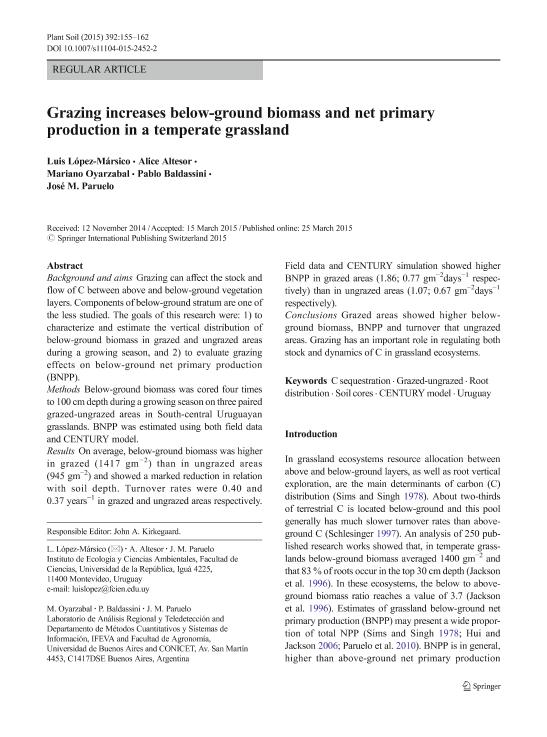Artículo
Grazing increases below-ground biomass and net primary production in a temperate grassland
Fecha de publicación:
07/2015
Editorial:
Springer
Revista:
Plant And Soil
ISSN:
0032-079X
e-ISSN:
1573-5036
Idioma:
Inglés
Tipo de recurso:
Artículo publicado
Clasificación temática:
Resumen
Background and aims: Grazing can affect the stock and flow of C between above and below-ground vegetation layers. Components of below-ground stratum are one of the less studied. The goals of this research were: 1) to characterize and estimate the vertical distribution of below-ground biomass in grazed and ungrazed areas during a growing season, and 2) to evaluate grazing effects on below-ground net primary production (BNPP).
Methods: Below-ground biomass was cored four times to 100 cm depth during a growing season on three paired grazed-ungrazed areas in South-central Uruguayan grasslands. BNPP was estimated using both field data and CENTURY model.
Results: On average, below-ground biomass was higher in grazed (1417 gm−2) than in ungrazed areas (945 gm−2) and showed a marked reduction in relation with soil depth. Turnover rates were 0.40 and 0.37 years−1 in grazed and ungrazed areas respectively. Field data and CENTURY simulation showed higher BNPP in grazed areas (1.86; 0.77 gm−2days−1 respectively) than in ungrazed areas (1.07; 0.67 gm−2days−1 respectively).
Conclusions: Grazed areas showed higher below-ground biomass, BNPP and turnover that ungrazed areas. Grazing has an important role in regulating both stock and dynamics of C in grassland ecosystems.
Archivos asociados
Licencia
Identificadores
Colecciones
Articulos(IFEVA)
Articulos de INST.D/INV.FISIOLOGICAS Y ECO.VINCULADAS A L/AGRIC
Articulos de INST.D/INV.FISIOLOGICAS Y ECO.VINCULADAS A L/AGRIC
Citación
Lopez Mársico, Luis; Altesor, Alice; Oyarzabal, Mariano; Baldassini, Pablo; Paruelo, José; Grazing increases below-ground biomass and net primary production in a temperate grassland; Springer; Plant And Soil; 392; 1; 7-2015; 155-162
Compartir
Altmétricas




